A Complete Guide to Visiting Lhasa – Part 2
A guide to visiting Lhasa for a tour of Lhasa that includes Lake Namtso means choosing both the tour operator and the right tour that will suit your needs and requirements. With thousands of tour operators online, this can be a confusing and complex matter. And there are a number of different tours that you can take in Lhasa that can give you a wide variety of experiences.
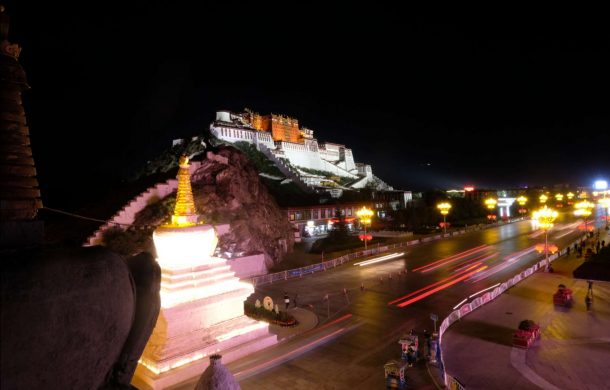
A night scene of the Potala Palace in Lhasa
Table of Contents
A guide to visiting Lhasa
The first thing to do when deciding on a tour of Lhasa, the capital of the Tibet Autonomous Region is deciding where you want to visit. Lhasa has a host of amazing places to see and plenty of things to do. So from visiting the temples and monasteries and touring the old cobbled streets of the Old Quarter to spending an afternoon in the vast garden park at Norbulingka Palace. And taking a trip to the Lalu Wetlands to see the huge number of wildfowls that inhabit the area.
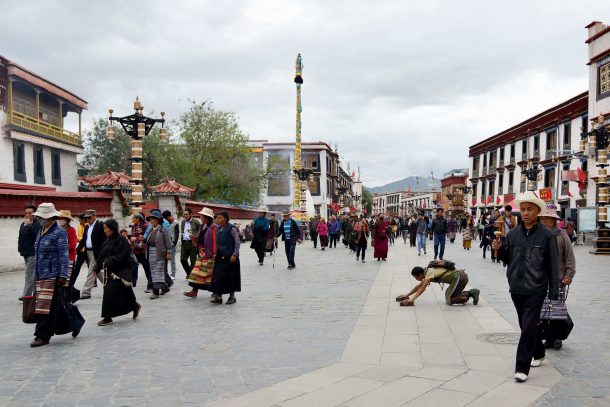
Tibetan pilgrims in Lhasa
There are a number of resources that you can use to find out what places there are that are worth visiting. By browsing the listed sites in Google to reading through some of our information on the best sights of Lhasa. You can even just come and talk to us and find out what there is to see and do. Our friendly and helpful staff will give you all the information you need.
Choosing the places you want to visit in Lhasa
Knowing where you want to go to Lhasa can also be confusing, as there is so much to see here. The main attractions in Lhasa for tourists are the Jokhang temple, the Potala Palace, Norbulingka Palace and Gardens, Sera and Drepung monasteries, Ganden Monastery, to name just a few.
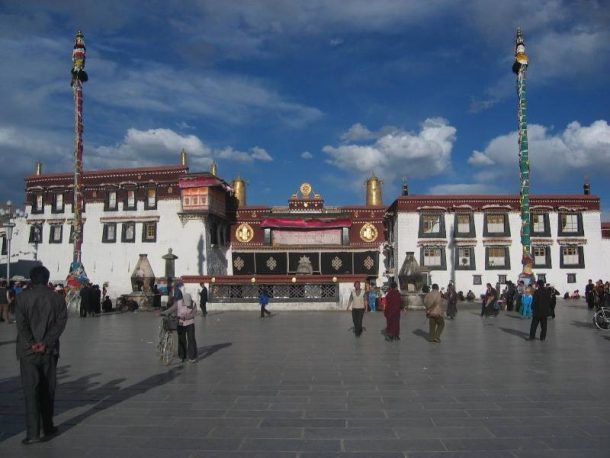
Jokhang Temple in Lhasa
Different tours of Lhasa can go to different places, though most of the tours do cover the main sights such as the Jokhang Temple, Potala Palace, etc. However, there are many places just outside the city that you may want to visit as well. Which do not require the additional permits for travel as they are within the Lhasa prefecture area of Tibet. Lhasa is a prefecture-level city, an idea that is unique to Chinese cities, and as such is more than just the city area itself. The range of “Lhasa” extends as far north as Damxung County and Lake Namtso. On the edges of the boundary with Nagqu, halfway to Shigatse City in the west, and as far east as Shijianlame Co.
Attractions outside the Lhasa City
Outside the city, you also have the option of visiting Lake Namtso, one of the Great Three holy lakes of Tibet. As well as Yangpachen, where the delightful hot springs make a nice break after taking a walk around the vast Lake Namtso nearby. In the west of Lhasa prefecture, in Maizhokunggar County, lies the Drigung Thil Monastery. The location of the best sky-burial site in Tibet, though you are not actually allowed into the burial site.
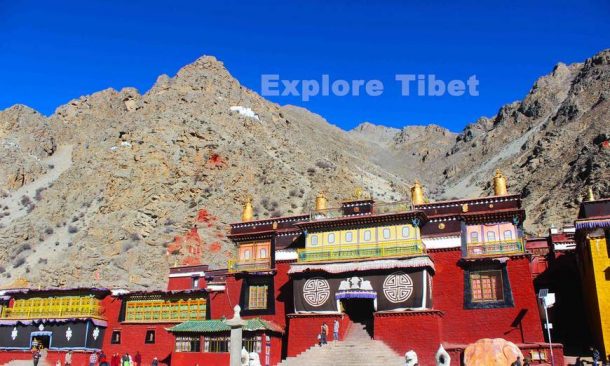
Tsurphu Monastery in Lhunzhub County
You can also visit the Tsurphu Monastery, the seat of the Karmapa School of Tibetan Buddhism; Reting Monastery, the most important Buddhist monastery in Lhunzhub County; and the famous Nyethang Drolma Temple. Which is associated with the Buddhist Master Atiśa, the founder of the Kadampa School of Tibetan Buddhism from around 1,000 years ago.
If you are feeling a little adventurous, and fancy doing some trekking while in Tibet. Then there is a great short trek that lasts just one day. This trekking route takes you around the 19 hermitages and nunneries in the hills just to the north of Lhasa. Part of the Sera Monastery, these hermitages have been used for meditation for more than 600 years, and are still in regular use today by some Buddhist hermits.
Once you have some idea of what to do and where to go around Lhasa. Then it is time to talk to a reputable tour operator about your proposal for a tour of the world’s highest capital city.
Choosing a tour operator
With the high cost of tours to Tibet, it is imperative that you find a good tour operator that can give you what you want at a price that is both reasonable and affordable. Searching on Google is the normal way people look for tour operators, though that can have some major disadvantages. Within the multitude of websites searchable on Google, there are some that are less than reputable. And plenty that is not even the actual tour operator, just middlemen that charge for their services.
Should I use a travel agent?
Travel agents are one of the most popular ways for western tourists to book their vacations. But with Tibet being a very restricted region of China, only a tour operator registered with the Tibet Tourism Bureau in Lhasa can actually run tours to the region. Travel agents, even the ones with their own premises, merely use the services of a registered tour operator to book your tour. And usually charge an additional fee for their services, making your tour more expensive than it should be.
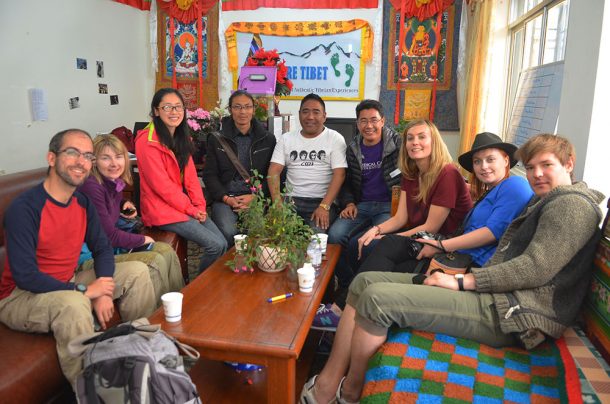
Group Tour Clients visit Explore Tibet Head office in Lhasa
What’s more, is that these “middle-men” often have no idea about the place you are traveling to. Other than what they have read in the third-party tour operator’s brochure or website. Here at Explore Tibet, we handle all our own tours. By using our own fully employed tour guides and driver, and our own vehicles for all our tours across Tibet.
Finding out about the tour operator
There are two sites on the internet, however, that can help you to decide which tour operator to use. They are recommended by a huge number of travelers around the world. Both Lonely Planet and TripAdvisor contain reviews of the businesses in Tibetan tourism by people that have actually used their services. The majority of the reputable companies that are registered as Tibetan tour operators have listings with these two popular websites.
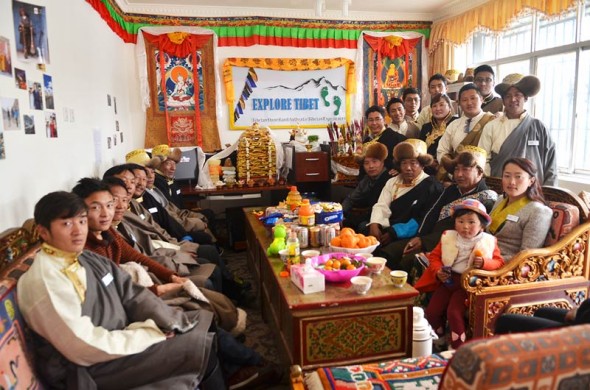
Explore Tibet, the #1 Tibetan tour operator according to the Lonely Planet Guide.
Those listings allow real travelers to post non-deletable reviews of their experiences with the tour operators. By giving you a good idea of how reliable the company is, as well as how well they look after their customers before, during, and after their tours. As one of the premier tour operators for Lhasa and Tibet. We are listed on both the Lonely Planet and the TripAdvisor websites and have some amazing reviews from our previous clients.
Using Lhasa-based tour operators
Another big issue when booking a tour with a tour operator is their location. Due to the huge number of visitors to Tibet every year. There are a vast number of tour operators that are based in other areas of China and who do not have any offices in the Tibetan capital. Most of these tour operators use locally-based Chinese. The Tibetan tour guides and drivers that are employed on a contract basis. And who can sometimes work for several mainland China tour operators at the same time.

Explore Tibet Small group Tour outside Lhasa
Most people prefer to travel with a tour operator that knows the area they are traveling to personally, and here at Explore Tibet. We know this area better than most since all our staff is based in Lhasa. Our office, which you will visit for lunch when you get to Tibet. It is also in the Tibetan capital, in Doudi Road, about a kilometer to the northeast of the Jokhang Temple.
Recent Posts
The Ultimate Guide to Tibet Tours, Travel, and Trekking Adventures
How to Explore Tibetan Culture
Exploring Lhasa:The Heart of Tibet
All Categories
- About Tibet
- book a Tibet tour
- Buddhism Practice
- Budget Tour
- China-Tibet Train
- Customized Tibet tour
- Historical Sites
- Hot Springs in Tibet
- News
- Photography in Tibet
- Tibet attraction
- Tibet Group Visa
- Tibet Motorcycle Tour
- Tibet Small Group Tours
- Tibet Tours and Tibetan Tour Guide
- Tibet Train
- Tibet Travel FAQs
- Tibet Travel Information
- Tibet Travel News
- Tibet Travel Permit Update
- Tibet Travel Prices Rises
- Tibet Trek
- Tibet Trekking Tour
- Tibet weather and climate
- Tibet Wildlife animals
- Tibet Winter Tour
- Tibetan Buddhism
- Tibetan Cultural Features
- Tibetan Culture and Poeple
- Tibetan Festivals
- What to see in Tibet



